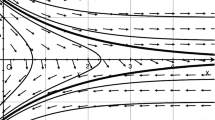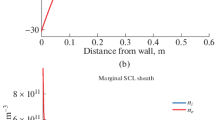Abstract
A classical problem of plasma physics is the treatment of the plasma-wall transition. This can be reached in the presheath with a presheath scale, in the sheath with a sheath scale and between presheath and sheath with an “intermediate scale”. Riemann (J Tech Phys 41:89–121, 2000) published a derivation of the intermediate scale. In our calculation we take the non-quasineutral values for the ion density and the ion velocity at the point where the non-quasineutral solution of the potential is zero. This approach is consistent and valid also for small but finite values of the smallness parameter of the theory. An effect of taking the non-quasineutral values is that the potential is shifted, dependent on the magnitude of the smallness parameter. But this shifting has no consequences on the intermediate scale and so we get a similar result as K.-U. Riemann. Furthermore, we show that it is not necessary to take into account the temperature change in the vicinity of the sheath edge and that it is possible to work always strictly with the complete and normalized basic equations of the problem and not only with orders on the left or right hand side of these equations.



Similar content being viewed by others
References
K.-U. Riemann, The influence of collisions on the plasma sheath transition. Phys. Plasmas 4(11), 4158–4166 (1997)
K.-U. Riemann, Theory of the plasma-sheath transition. J. Tech. Phys. 41, 89–121 (2000)
A. Schneider, Comprehensive analytical description of the plasma-wall-transition with particular emphasis of the intermediate scale. Ph.D.-thesis, p. 59 ff, University of Innsbruck (2009)
U. Stroth, Plasmaphysik - Phänomene, Grundlagen, Anwendung (Springer, Berlin, 2011)
E. Hille, Ordinary Differential Equations in the Complex Domain (Wiley, New York, 1976)
S. Kuhn, K.-U. Riemann, N. Jelić, D.D. Tskhakaya Sr., D. Tskhakaya Jr., M. Stanojević, Link between fluid and kinetic parameters near the plasma boundary. Phys. Plasmas 13, 013503 (2006). https://doi.org/10.1063/1.2161181
N. Jelić, K.-U. Riemann, T. Gyergyek, S. Kuhn, M. Stanojević, J. Duhovnik, Fluid and kinetic parameters near the plasma-sheath boundary for finite Debye lengths. Phys. Plasmas 14, 103506 (2007). https://doi.org/10.1063/1.2793737
L. Kos, N. Jelić, S. Kuhn, D.D. Tskhakaya, Introduction to the theory and application of a unified Bohm criterion for arbitrary-ion-temperature collision-free plasmas with finite Debye lengths. Phys. Plasmas 25, 043509 (2018). https://doi.org/10.1063/1.5030121
T. Gyergyek, J. Kovačič, Numerical analysis of ion temperature effects to the plasma wall transition using a one-dimensional two-fluid model. I. Finite Debye to ionization length ratio. Phys. Plasmas 24, 063505 (2017). https://doi.org/10.1063/1.4984786
T. Gyergyek, J. Kovačič, Numerical analysis of ion temperature effects to the plasma wall transition using a one-dimensional two-fluid model. II. Asymptotic two-scale limit. Phys. Plasmas 24, 063506 (2017). https://doi.org/10.1063/1.4984787
L. Kos, D.D. Tskhakaya Sr., N. Jelić, Unified Bohm criterion. Phys. Plasmas 22, 093503 (2015). https://doi.org/10.1063/1.4930207
L. Kos, N. Jelić, S. Kuhn, D.D. Tskhakaya, Modeling and simulations of plasma and sheath edges in warm-ion collision-free discharges. AIP Adv. 8, 105311 (2018). https://doi.org/10.1063/1.5044664
Acknowledgements
For the possibility to realize this work I gratefully acknowledge substantial financial support from Austrian Science Fund (FWF), Projects P15030; P16187 and P19235 and from project P1 of the association EURATOM-AW; without all of them this paper could not have been published.
Author information
Authors and Affiliations
Corresponding author
Additional information
Publisher's Note
Springer Nature remains neutral with regard to jurisdictional claims in published maps and institutional affiliations.
Appendix
Appendix
Derivation of the (presheath) equation
with
We choose \(x_1=0\) for the zero point of the potential. The presheath equations and the electron density read for a planar sheath (in our derivation!) after expanding the expression \(\left( \nu + \sigma _\mathrm{se} / {\hat{n}}_\mathrm{i}\right) u\) up to the first term
The smallness parameter \(\varepsilon \) is taken small in comparision to one \((0<\varepsilon \ll 1)\). For \(\varepsilon \rightarrow 0\) (34) means that
in the vicinity of \(x_1=0\).
We integrate Eq. (38) and use the integrated continuity equation. Defining
and solving a quadratic equation in \(\varDelta \) and neglecting third and higher order terms we get with the ansatz \({{\hat{n}}}_\mathrm{i}(0)=1+C_1 \varepsilon ^{4/5}\) [confer Eq. (30)] and \(u(0)=1+C_2' \varepsilon ^{q_2'}+ C_2 \varepsilon ^{q_2}+\cdots \) [\(q_2>0\), \(q_2'>0\), Fig. 3 and Eq. (6)]
With our previous definition (41) we get finally with Eqs. (36) and (39) using the previous ansatz [confer Eqs. (6) and (30)] and neglecting third order and higher terms
or
We assumed in the previous derivation that \(\varphi ^2(x)\approx x\) (confer also [1], equation 18) in the vicinity of \(x_1=0\) for \(0<\varepsilon \ll 1\) and \(x<0\). This assumption is justified by the result (44). So we can conclude that
The derivation of the sheath equation
with
is quite similar.
Rights and permissions
About this article
Cite this article
Schneider, A. Precise Derivation of the Intermediate Scale. J Fusion Energ 39, 53–60 (2020). https://doi.org/10.1007/s10894-020-00234-9
Published:
Issue Date:
DOI: https://doi.org/10.1007/s10894-020-00234-9




